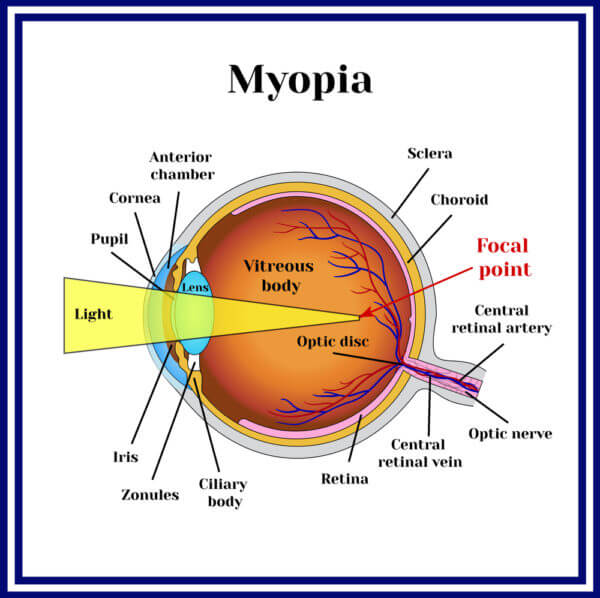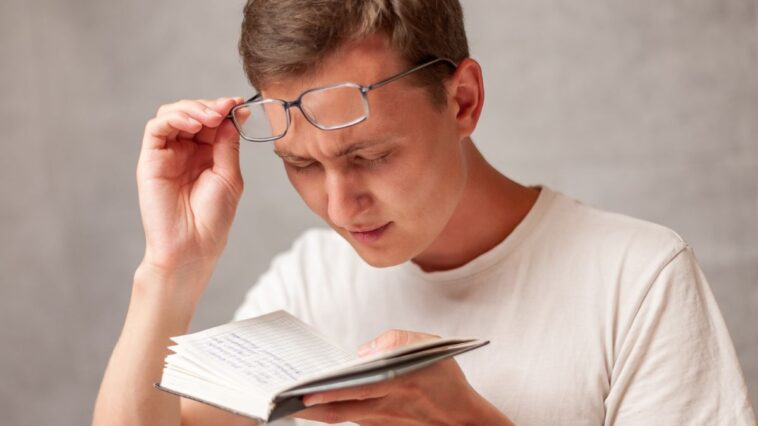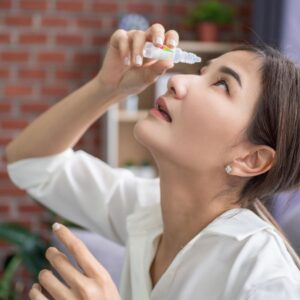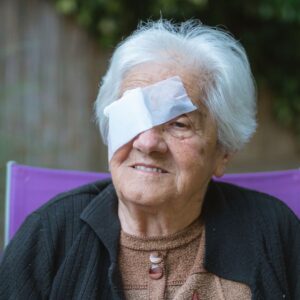What is Myopia?
Myopia, also called nearsightedness, is a common eye condition that affects a person’s ability to see distant objects clearly. It occurs when the eye is too long, causing light rays to focus in front of the retina instead of directly on it. As a result, distant objects appear blurry or out of focus, while near objects appear clear.
Myopia typically develops in childhood and can worsen as a person ages. It can be corrected with eyeglasses, contact lenses, or refractive surgery. Myopia can lead to other eye problems, such as cataracts, glaucoma, and retinal detachment, if left untreated.

Types of Myopia
Several different types of myopia can occur, including:
- Simple myopia: This is the most common type of myopia, in which distant objects appear blurry while near objects are seen clearly. An elongated eyeball typically causes it.
- Pathological myopia: This is a severe form of myopia associated with structural changes in the eye. People with pathological myopia have a higher risk of developing retinal detachment, macular degeneration, and other vision problems.
- Degenerative or high myopia occurs when the eyeball is significantly elongated, causing extreme nearsightedness. It can lead to retinal degeneration and other complications.
- Nocturnal myopia occurs when the eyes have difficulty adjusting to low-light conditions, such as during nighttime or in dimly lit environments.
- Pseudomyopia: This is a temporary type of myopia that occurs due to ciliary muscle spasm, which causes the eye’s lens to become more curved, resulting in temporary blurry distance vision.
It’s important to note that myopia can also be classified based on its severity, ranging from mild to severe, depending on the degree of nearsightedness.
What Causes Myopia?
The exact cause of myopia is not fully understood, but it is believed to be the result of both genetic and environmental factors. Here are some of the common factors that may contribute to the development of myopia:
- Genetics: Myopia tends to run in families, suggesting a genetic component.
- Environmental factors: Prolonged near tasks such as reading and using electronic devices, lack of exposure to sunlight, and dim lighting have been noted in individuals that have or have developed myopia.
- Refractive errors: Myopia is an eye condition caused by an abnormal shape or size of the eye, cornea, or lens. This refractive error can cause difficulty focusing on objects that are far away.
- Age: Myopia develops in childhood and can often worsen during adolescence. However, it is also possible for adults to develop myopia.
- Health conditions: Certain health conditions, such as diabetes, can cause an increased risk of developing myopia.
Overall, the causes of myopia are complex and may involve a combination of genetic and environmental factors.
Symptoms of Myopia
The most common symptom of myopia, also known as nearsightedness, is difficulty seeing distant objects clearly. Other symptoms may include:
- Squinting: Squinting helps to temporarily improve the clarity of vision by reducing the size of the blurred image on the retina.
- Eye strain: Straining to see distant objects can cause eye fatigue, headaches, and discomfort.
- Blurred vision: Distant objects appear blurry while nearby objects appear clear.
- Difficulty seeing at night: People with myopia may experience more difficulty seeing in low-light conditions, such as at night.
- Needing to sit closer to the TV or computer screen: This may indicate difficulty seeing distant objects.
- Frequent eye rubbing: This can indicate eye fatigue or strain.
- Tilting the head or squinting to see better: Tilting the head or squinting can help to improve focus on distant objects.
It’s important to note that some people with myopia may not experience noticeable symptoms, especially if the condition is mild. Therefore, it’s essential to have regular eye exams to detect and diagnose myopia.
Diagnosis of Myopia
Myopia, also known as nearsightedness, can be diagnosed through a comprehensive eye examination by an optometrist or ophthalmologist. The examination may include the following tests:
- Refraction test: To diagnose myopia and assess its severity, an eye doctor will measure a person’s vision through a refraction test. During this test, the person will look at various lenses to find which gives them the sharpest and clearest vision.
- Visual acuity: Myopia is typically identified through a visual acuity test, which measures how well a person can read letters or numbers on an eye chart from a set distance. People with myopia typically struggle to see clearly at distances beyond the chart.
- Retinal examination: This test inspects the back of the eye for abnormalities caused by severe myopia, such as retinal tears or detachment.
- Autorefractor: An autorefractor is an automated machine that can measure myopia quickly and accurately.
- Keratometry: This test measures the cornea’s curvature, vital in deciding what prescription is needed for your eyeglasses or contact lenses.
Regular comprehensive eye exams are essential to monitor any changes in your myopia and keep your eyes healthy.
Treatment for Myopia
Several treatment options are available for myopia, ranging from corrective lenses to surgical procedures. Here are some of the most common treatment options:
- Eyeglasses: Wearing eyeglasses is a common way to correct myopia. These glasses feature lenses designed with a specific corrective power that helps to bring images into focus on the back surface of your eyes. This improves vision and eliminates blurry or distorted images caused by the refractive error in your eye.
- Contact lenses: Contact lenses are an ideal vision correction solution for those with myopia. With the help of an experienced optometrist or eye care provider, you can find the perfect pair of contacts to suit your unique vision needs. Several types of contact lenses are available, including soft, rigid gas permeable (RGP), and hybrid lenses. These lens types vary in material composition, design, durability, and wearability.
- Orthokeratology: Orthokeratology is a type of vision correction for myopia that involves wearing custom-made contact lenses while you sleep. These lenses are designed to reshape the cornea and improve your vision temporarily, so you no longer need to wear eyeglasses or contacts during the day. When you wake up
- Refractive surgery: Refractive surgery such as LASIK can permanently correct myopia by reshaping the cornea and improving vision for those suffering from this condition.
- Atropine eye drops: Atropine eye drops may be beneficial for children developing myopia as they can help slow the progression of their condition. The drops temporarily paralyze the eye’s focusing power, relaxing the eyes and encouraging them to focus more naturally.
Treatment choice depends on several factors, such as the severity of myopia, age, lifestyle, and personal preference. It’s essential to consult with an eye doctor to determine the best treatment option for your individual needs.
Preventing the Progression of Myopia
While there is no known cure for myopia, there are several ways to help slow down or prevent the progression of myopia in children and adults. Here are some tips:
- Outdoor time: Increasing time spent outside has been proven to help reduce the risk of myopia developing or worsening in children. Aim to have kids spend at least two hours a day out of doors, participating in activities such as sports or games.
- Limit screen time: With increasing technological advancement, we spend more and more time looking at screens close to our faces. To reduce the risk of myopia progression, children and adults must limit their screen time by taking frequent breaks.
- Proper lighting: Without enough light, the eyes can become strained and tired, leading to further deterioration of vision. Thus, a well-lit environment is essential to reduce eye fatigue and ensure healthy eyesight.
- Distance from screens: Maintaining a safe distance between electronic devices and your eyes is crucial to prevent myopia from worsening. Encourage children and adults to regularly take breaks from screens and keep their viewing distance reasonable to combat the onset of myopia.
- Corrective lenses: Wearing the correct prescription glasses or contact lenses can reduce eye strain and prevent the further progression of myopia.
- Vision therapy: which may include eye exercises and tools such as lenses and prisms, has been shown to help slow the progression of myopia. This treatment can help improve visual acuity and reduce eye strain that can worsen nearsightedness.
It’s essential to consult with an eye doctor for guidance on the best strategies to help prevent myopia progression. Regular eye exams can also help detect myopia early and monitor any vision changes.
Does Myopia Get Worse With Age?
Myopia can worsen with age, but it’s not always the case. In many cases, myopia stabilizes by the age of 20 or 30. However, some people may experience a gradual worsening of myopia throughout their lifetime.
The risk of myopia progression is higher in children and teenagers, as their eyes are still developing. If myopia develops at an early age, the risk of progression is higher. Studies have shown that children with higher degrees of myopia are more likely to experience a greater rate of progression as they age.
What is The Highest Myopia?
The highest degree of myopia is typically measured in diopters (D). Diopters represent the refractive power of a lens required to correct the degree of myopia.
Extreme or high myopia is typically considered a refractive error of -6.00 D or worse. This level of myopia is also called pathological or degenerative myopia, and it is associated with a higher risk of complications like retinal detachment, myopic maculopathy, and glaucoma.
In some rare cases, myopia can progress to very high levels, such as -20.00 D or even higher. However, such extreme levels of myopia are not common and are usually associated with severe complications that can lead to vision loss.
Regular eye exams are necessary to maintain good eyesight and detect any changes. If you experience any symptoms related to myopia or its possible further complications, it is necessary to seek prompt, professional health care.
Conclusion
Myopia, or nearsightedness, is a common eye condition where distant objects appear blurry while close objects are clear. It occurs when the eyeball is too long, or the cornea is too curved, causing the light entering the eye to focus in front of the retina instead of directly on it.
The most common symptoms of myopia include blurred vision, headaches, and eye strain. A comprehensive eye exam can diagnose it, including visual acuity and refraction tests.
Several treatment options are available for myopia, including corrective lenses, orthokeratology, refractive surgery, atropine eye drops, and vision therapy. In addition, specific lifestyle changes, such as spending more time outdoors, limiting screen time, and maintaining proper lighting, can help prevent myopia progression.
It’s essential to consult with an eye doctor for guidance on the best treatment options and strategies to manage myopia. Early detection and intervention can help prevent further vision problems and maintain good eye health.






